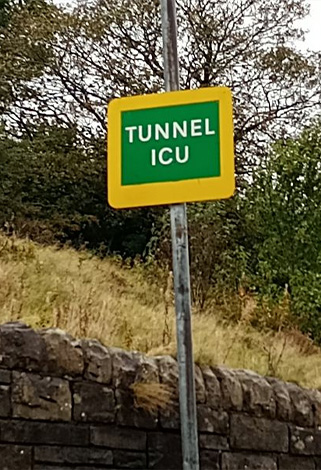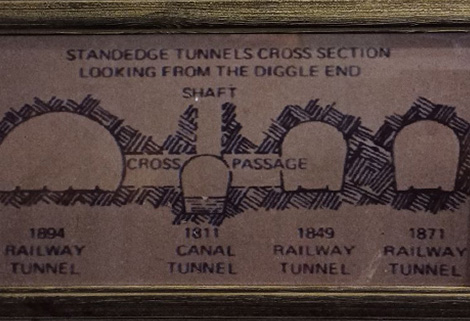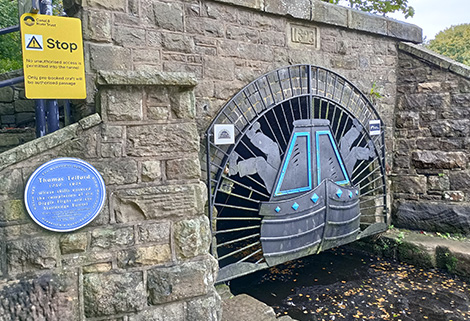https://canalsonline.uk/journeying-through-the-standedge-tunnel
The Huddersfield Narrow Canal
In 1794 acts of Parliament were passed to build two new canals, The Rochdale and The Huddersfield Narrow Canal. Direct routes between Manchester, the north-west and Yorkshire were needed to transport goods between the centres of industry. The goods were principally textiles: wool and cotton and their raw components. The HNC connected Aston under Lyme in Greater Manchester (then Lancashire) with Huddersfield in West Yorkshire.
This very beautiful canal is 19.3 miles long and has narrow 74 locks. It is a journey through woodland, moors, industrial towns and historic mill villages. The summit pound is the highest in Britain but perhaps the canals most remarkable feature is The Standedge Tunnel which connects Diggle to Marsden. Robert Aickman proposed it as one of the Seven Wonders of The Waterways.
 The Standedge Tunnel
The Standedge Tunnel
• 3.2 miles through gritstone,
• 640ft under the surrounding hills of The Pennines.
• 643ft above sea level.
• The Highest, Longest, Deepest tunnel in the Country.
Construction Difficulties
Construction of the Standedge Tunnel began from both ends in 1798; a tunnel rather than more locks was thought to be a better option due to concerns about water shortages. The main bulk of the excavating and mining being done by Irish navvies, Cornish tin miners and local farm labours, around 2500 men were employed during the 17 year project. The bold scheme met with difficulties from the start. Numerous factors slowed down the tunnelling: cut backs were enforced such as halting the construction of smaller tunnels to supply waterwheels used to raise soil and waste. Higher than expected water levels within the tunnel were found and poor drainage provision hampered the work. The main contractor suffered large losses and needed extra funding to continue and when he pulled out nobody else wanted to tender for the job.
Poor working practises made the conditions underground for the navvies extremely dangerous: The work was carried out by candle light, the air quality was very bad, and the rock was blasted away by gun powered. Several men lost their lives in explosions. Officially 50 men died of various causes but there were probably many more as those that died at home did not figure in the official count. The Diggle Hotel, which still stand today, was used a morgue.
There were squabbles and disagreements with the overseers of the tunnelling too. The mill owners, who had partially financed the venture, disagreed on many details. The original engineer, Benjamin Outram withdrew from the scheme due to ongoing complications, complaints and ill health. Finally, after a period of inactivity, the canal committee applied successfully to Parliament for more money to complete the project. Canal royalty, Thomas Telford, was asked for his advice which resulted in a new plan being drawn up for its competition. The two ends of the tunnel met in 1809 but they weren’t quite square so the tunnel now has its famous S bend.
Daily Workings through the Tunnel
Despite all the difficulties, the first boat passed through the tunnel in 1810 and in March 1811 it was complete with a grand opening ceremony being held a few weeks later. Several boats carrying invited guests transited the tunnel in a time of 1 hour 40 minutes. The tunnel had cost £160.000 making it the most expensive in Britain.
Professional ‘Leggers’ were employed to power the barges through the tunnel. Working in pairs they were paid one shilling and sixpence per boat. To stop arguments about who was going to go through first a young boy was employed to organise the crews. He was also responsible to walking the horses up and over the fell to the other side. When all the horses had been claimed, he knew that no boats were inside and he could let the next group of boats pass through. He did this job for 37 years with only a day off each year for Christmas. His family lived in the building that is now the café.
Between its opening day and 1840 the tunnel was used by around 40 boats daily. The passage was only open to single boat working (although there are a few passing places) and with an empty boat taking around 1 hour 20 mins and 3 hours for a laden one, the competitiveness of the canal suffered, especially when it was compared to its rival The Rochdale Canal just the other side of the fell. Another difficulty was that the HNC was built for 70ft narrow boats while the Hudderfield Broad Canal could take wider but shorter 57ft boats as used on the Calder and Hebble navigation. This meant that goods had to be transferred between the two canals at Huddersfield which increased costs to levels that weren’t sustainable. This was exacerbated by the coming of the Huddersfield and Manchester railway.
Demise of the Huddersfield Narrow Canal
Three railway tunnels run parallel to the canal tunnel. The first opened in 1848 with a second one opening in 1871. The trains carried goods between Manchester and Huddersfield, two major centres in the textile industries. The third, double track line is the only one used today; the other two are disused but still intact. All four tunnels are linked by adits and cross tunnels. Ironically the canal was used to remove the spoil from the construction of the railway which allowed it to be built in just 3 years without the need for construction shafts.
With the railways taking trade away from the canals the HNC fell into a slow decline, with the last commercial boat transiting in 1921. In 1944 the canal was officially closed although in 1948 ‘The Alisa Craig’ helmed by L.T.C.Rolt, and Robert Aickman, two of the founders of the Inland Waterways Association, did managed to struggle through. She was the last barge to pass along the canal before the lock gates were removed in the 1950s.
A maintenance boat was housed at the summit level tasked with carrying out inspections and basic work within the tunnel. In 1960/61 this boat took canal enthusiasts on trips through the tunnel but parts of the roof had become unstable and eventually collapsed making the excursions impossible. At the time of the closure a local newspaper reporting that satanic rituals were taking place and that workers had found strange wall art and severed sheeps’ heads deep in the heart of The Pennines!
The Restoration of the Canal and Tunnel
In the 1990s the money finally became available to restore the tunnel thanks to the efforts of The Huddersfield Canal Society and the local community. It was in a bad state of repair with over 1.5 miles of tunnel impassable due to rock falls. Many sections had to be stabilised with rock bolts and lined with concrete. Over 3,000 tons of rocks had to be removed along with 10,000 tons of silt. The total cost of repairing the tunnel was over 5 million pounds: rather a lot more than the original cost. The tunnel was officially opened by the then Prince Charles on May 1st 2001.
Initially it was considered unsafe for modern diesel powered boats to pass through the tunnel using their engines due to lack of ventilation and they were assisted through by an electric tug boat. However since 2009 boats have been able to pass through under their own power.
The Tunnel is said to be haunted as visitors and staff have reported seeing strange lights, hearing unexplained sounds and there are rumours of a mysterious robed figure….During the autumn of 2023 a group of enthusiasts are undertaking a paranormal investigation within the tunnel.


The Standedge Tunnel today.
Today it is possible to helm your own boat through the tunnel. The average time to transit is 2 hours. A trained volunteer chaperone accompanies you on your boat. A second team member drives along the disused train tunnel parallel to the canal tunnel and meets you at adits along the way.
How to book
It is necessary to book your passage through the tunnel at least 3 days in advance. Passage from Marsden to Diggle is between 0830 and 1030 am and between Diggle to Marsden between 1300 hrs and 1430 hrs. Booking can be done online or by ringing 03030 404040 and speaking to the Yorkshire and NE customer service team. Places and dates are limited. In 2023, around 200 boats used the tunnel. Passage down The Marsden Flight also needs to be booked so that the top lock can be unlocked.
What to expect
Helming your own boat through the Standedge Tunnel is an amazing experience. After a while you become accustomed to the dark and the restricted head room and relax and start to enjoy the journey. The CRT volunteers provide hard hats and extra lights for your boat and the chaperone is calm and reassuring as well as being very knowledgeable about the history of the tunnel. It is rather wet in places and a tight fit but we passed through without damaging our boat (we had taken off the covers to our navigation lights beforehand). If you don’t fancy the idea of helming yourself the volunteers will do it for you and meet you at the other side. At the Marsden entrance there is are a café, shop and visitors centre which are well worth stopping for.
This canal is one of my all-time favourites; it is diverse, exciting, hard work but enormously rewarding. I highly recommend it.
